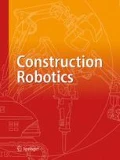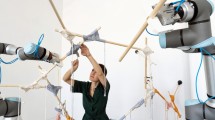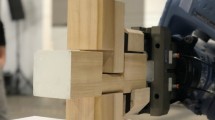Abstract
The architectural heritage of Valparaíso, Chile is disappearing before our eyes while all the conventional resources to reverse this situation seem to have been exhausted. A large portion of the existing historic building substance consists of timber frames that succumb one after another to weathering, termites and structural fires. The acute shortage of traditional timber framers and a weak local heritage industry feed investors’ disinterest in preserving the original structural conception of these timber-framed buildings when they need restoration or rehabilitation. There is a need for technological innovation enabling one-off production of complex-skilled joinery at competitive costs. Robotic machining emerges as a flexible and customizable alternative to the missing timber framers and the insensible substitution of original timber joints for metal fasteners. We present a proof-of-concept of parametric 3D modelling and robot path generation using a single visual scripting environment integrated to CAD software that requires no knowledge of robot programming and might encourage designers as well as small- and medium-sized manufacturers to develop a local heritage industry. Several classes of timber joints found in Valparaíso were parameterized and instances thereof manufactured by a six-axis industrial robot with a spindle mounted thereon to gain empirical knowledge of the entire process. Experimental results show that procedural modelling of parts, assemblies, and tool paths in the tested visual scripting environment is time-consuming and rather complicated for conventional architectural thinking, but is largely compensated by its software and hardware interaction potential.








Similar content being viewed by others
References
Barberot JECÉ (1911) Traité pratique de charpente. Ch. Beranger, Paris
Biston V, Boutereau C, Hanus PA (1842) Nouveau manuel complet du charpentier. La Librarie Encyclopedique de Roret, Paris
Braumann J, Brell-Çokcan S (2011) Parametric robot control: Integrated CAD/CAM for architectural design. In: Taron J, Parlac V, Kolarevic B, Johnson J (eds) Integration through computation: Proceedings of the 31st annual conference of the association for computer aided design in architecture (ACADIA), Calgary/Banff, Canada, October 11–16, 2011, pp. 242–251, The University of Calgary
Cabanié B (1864) Charpente générale théorique et pratique (2 tomos). Gauthier-Villar, Paris (1864 [1848])
Chiarella M, González LF, Calvo C (2013) Robots: automatización en diseño y construcción para la enseñanza de arquitectura. In: Bernal M, Gómez P (eds) Proceedings of the 17th SIGraDi Conference, Valparaíso, Chile, 20–22 November 2013, pp. pp. 439–443. Universidad Técnica Federico Santa María
Dank R, Freißling C (2013) The framed pavilion: modeling and producing complex systems in architectural education. In: Brell-Çokcan S, Braumann J (eds) Rob | Arch 2012: robotic fabrication in architecture, art and design. Springer Wien New York, Vienna, pp 238–247
Emy A-R (1841) Traité de l’Art de la Charpenterie. Meline, Cans
Gaztelu L (1899) Carpintería de armar. De Bailly-Bailliere e hijos, Madrid
Gerner M (1992) Handwerkliche Holzverbindungen der Zimmerer. Deutsche Verlags-Anstalt DVA, Stuttgart
Gramazio F, Kohler M (2014) The robotic touch: how robots change architecture. Park Books, Zürich
Guarda G (1995) La tradición de la madera (the tradition of wood). Ediciones Universidad Católica de Chile, Santiago
Iglesias I, Sebastián MA, Ares JE (2015) Overview of the state of robotic machining: current situation and future potential. Procedia Eng 132(2015):911–917
Johns RL, Foley N (2014) Bandsawn bands feature-based design and fabrication of nested freeform surfaces in wood. In: McGEE W, Ponce de León M (eds) Robotic fabrication in architecture, art and design 2014, pp. 17–32. Springer, Switzerland
León C, Cubillos J (2016) Robotically milled timber frame prototype. In: González LF (ed) Creative robotics at UTFSM, Valparaíso, Chile. https://vimeo.com/201582785. Accessed 24 May 2017
Lohrmann E (2016) When imagination falls short: Advanced industry, the coming industry. Speech of KUKA Roboter GmbH Sales Channel Director for Africa, Europe, Latin-America and Middle-East held at the XVII Annual Industry Forum 2016 organized by the Metallurgical and Metal-Mechanic Industries Association (ASIMET), Santiago, Chile, August 10, 2016
Lohrmann E (2016) Productivity and robotics in emerging economies. Speech of KUKA Roboter GmbH Sales Channel Director for Africa, Europe, Latin-America and Middle-East held at Universidad Técnica Federico Santa María, Valparaíso, Chile, August 8, 2016
Oslet G (1980) Traité de charpente en bois. H. Chairgrasse fils Paris
Pandremenos J, Doukas C, Stavropoulos P, Chryssolouris G (2011) Machining with robots: a critical review. In: 7th international conference on digital enterprise technology DET2011, Athens, Greece, September 28–30, 2011
Parisi MA, Piazza M (2002) Seismic behavior and retrofitting of joints in traditional timber roof structures. Soil Dyn Earthq Eng 22(9–12):1183–1191
Reuleaux F (1876) The kinematics of machinery. Macmillan & Co, New York
Robeller C, Weinand Y (2016) Fabrication-aware design of timber folded plate shells with double through tenon joints. In: Reinhardt D, Saunders R, Burry J (eds) Robotic fabrication in architecture, art and design 2016. Springer, Switzerland, pp 167–177
Robeller C, Nabaei SS, Yves W (2014) Design and fabrication of robot-manufactured joints for a curved-folded thin-shell structure made from CLT. In: McGee W, Ponce de León M (eds) Robotic fabrication in architecture, art and design 2014, pp. 67–81. Springer, Switzerland
RobotWorx (2017) How much do industrial robots cost? https://www.robots.com/faq/show/how-much-do-industrial-robots-cost. Accessed 23 April 2017
Schwartz T (2013) HAL: extension of a visual programming language to support teaching and research on robotics applied to construction. In: Brell-Çokcan S, Braumann J (eds) Rob | Arch 2012: robotic fabrication in architecture, art and design. Springer Wien New York, Vienna, pp 92–101
Schwinn T, Krieg OD, Menges A (2013) Robotically fabricated wood plate morphologies: robotic prefabrication of a biomimetic, geometrically differentiated, lightweight, finger joint timber plate structure. In: Brell-Çokcan S, Braumann J (eds) Rob | Arch 2012: robotic fabrication in architecture, art and design. Springer Wien New York, Vienna, pp 48–61
Søndergaard A, Amir O, Eversmann P, Piskorec L, Stan F, Gramazio F, Kohler M (2016) Topology optimization and robotic fabrication of advanced timber space-frame structures. In: Reinhardt D, Saunders R, Burry J (eds) Robotic fabrication in architecture, art and design 2016. Springer, Switzerland, pp 191–203
Tamke M, Thomsen MR (2008) Designing parametric timber. In: Muylle M, de Vos E (eds) 26th eCAADe Conference, Antwerpen, Belgium, September 17–19, 2008, pp. 609–616, University of Antwerpen
Tamke M, Thomsen MR (2009) Digital wood craft. In: Tidafi T, Dorta T (eds) 13th International CAAD futures conference, montréal, Canada, June 17–19, 2009, pp. 673–686, Université de Montréal
Williams N, Cherrey J (2016) Crafting robustness: rapidly fabricating ruled surface acoustic panels. In: Reinhardt D, Saunders R, Burry J (eds) Robotic fabrication in architecture, art and design 2016. Springer, Switzerland, pp 295–303
Acknowledgements
This research is funded by Grant FONDEF ID14I10378 from the Fund for the Promotion of Scientific and Technological Development (FONDEF) managed by the National Commission for Scientific and Technological Research of Chile (CONICYT). For more information please visit: vimeo.com/199477171. We want to thank Prof. Dr.-Ing. Eugenio González and the Integrated Center for Manufacturing and Automation CIMA at UTFSM.
Author information
Authors and Affiliations
Corresponding author
Rights and permissions
About this article
Cite this article
González Böhme, L.F., Quitral Zapata, F. & Maino Ansaldo, S. Roboticus tignarius: robotic reproduction of traditional timber joints for the reconstruction of the architectural heritage of Valparaíso. Constr Robot 1, 61–68 (2017). https://doi.org/10.1007/s41693-017-0002-6
Received:
Accepted:
Published:
Issue Date:
DOI: https://doi.org/10.1007/s41693-017-0002-6




